 W
WThe Flag of the Colony of Aden was used as the official flag for the British Colony of Aden from 1937 until 18 January 1963 when it was renamed the State of Aden and subsequently used the Flag of the State of Aden under the Federation of South Arabia. However, there is evidence that the flag was used after 1963 in Perim and the Kuria Muria islands.
 W
WThe Australian Red Ensign resulted from the Commonwealth Government's 1901 Federal Flag Design Competition which required two entries: a flag for official Commonwealth Government use and another for the merchant navy. The winning design was based on the traditional British Red Ensign and featured the Southern Cross and Commonwealth Star.
 W
WThe flag of the British Overseas Territory of Bermuda as a red ensign was first adopted on 4 October 1910. It is a British Red Ensign with the Union Flag in the upper left corner, and the coat of arms of Bermuda in the lower right. Prior to this like most of the British colonies at the time it adopted a blue ensign with a seal that depicted a dry dock with three sailing ships. In 1999, the flag was changed to its current form, with an enlarged coat of arms.
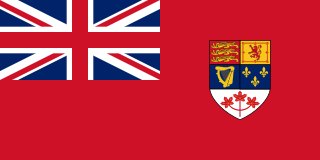 W
WThe Canadian Red Ensign served as a nautical flag and civil ensign for Canada from 1892 to 1965 and later as an unofficial flag of Canada before 1965. The flag is a British red ensign, with the Royal Union Flag in the canton, adorned with the shield of the coat of arms of Canada.
 W
WThe flag of Cape Colony was the official flag of the Cape Colony from 1876 to 1910. It formed part of a system of colonial flags that was used throughout the British Empire.
 W
WThe flag of the East India Company was used to represent the East India Company, which was chartered in England in 1600. The flag was altered as the nation changed from England to Great Britain to the United Kingdom. It was initially a red and white striped ensign with the flag of England in the canton. The flag displayed in the canton was later replaced by the flag of Great Britain and then the flag of the United Kingdom, as the nation developed.
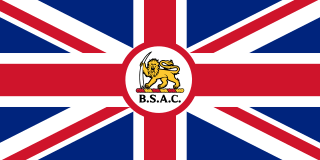 W
WThe Flag of the British South Africa Company was the flag used by the British South Africa Company (BSAC) and Rhodesia under company rule. It was adopted in 1892 and was used until 1923 when the south of Rhodesia voted to become Southern Rhodesia and the north was surrendered to the Colonial Office to become Northern Rhodesia. The flag remained as the Company's commercial flag until 1965. The flag consisted of a British Union Flag with the Company's logo of a lion and tusk on a white circle in the centre with "B.S.A.C." underneath it.
 W
WThe Green Ensign is a historical flag flown by some Irish merchant vessels from before the 19th century to the early 20th century. The flag consists of a green field with a golden harp and a canton containing either the English Flag or a version of the Union Jack.
 W
WThe Historical flags of the British Empire and the overseas territories refers to the various flags that were used across the various Dominions, Crown Colonies, Protectorates, territories which made up the British Empire and current Overseas territories. Early flags that were used across the Empire tended to variations of the Red and Blue Ensigns of Great Britain with no colonial badges or coat of arms attached to them. In the first half of the 19th Century, the first colonies started to acquire their own colony badges, but it was not until the UK Parliament passed the Colonial Naval Defence Act 1865 that the colonies were required to apply their own emblems.
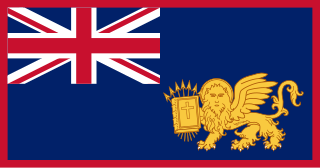 W
WThe Flag of the United States of the Ionian Islands was used between 1815 and 1864. The flag consisted of a British blue ensign with the coat of arms of the predecessor state, the Septinsular Republic on it with a red border.
 W
WThe flag of Montserrat is the Montserrat arms placed on the fly of the British Blue Ensign after the colony of the Leeward Islands was dissolved in 1958.
 W
WThe Flag of Nigeria between 1914 and 1960 was a British blue ensign with a green Star of David surrounding a Tudor Crown with the white word "Nigeria" under it on a red disc. It was adopted by the Colony and Protectorate of Nigeria following the amalgamation of the Southern Nigeria Protectorate and Northern Nigeria Protectorate.
 W
WThe Flag of the Orange River Colony was the official flag of the Orange River Colony in South Africa from 1903 to 1910. It formed part of a system of colonial flags that was used throughout the British Empire. It was superseded by the Flag of the Union of South Africa.
 W
WDuring the British Mandate over Palestine between 1920 and 1948, officially recognized by the League of Nations in the Palestine Mandate, the de facto flag was the Union Jack or Union Flag of the United Kingdom, but several localised flags existed for Mandate government departments and government officials. The only Palestine-specific flag not restricted to official government use was the Palestine ensign, which was flown by ships registered in the British Mandate territory from 1927 to 1948. This flag had an extremely limited use on land and was not embraced by either the Arabs or the Jews of the Palestine mandate territory. It was based on the British Red Ensign instead of the Blue Ensign since it was intended for use only at sea by non-government ships.
 W
WThe Flag of the Federation of Rhodesia and Nyasaland was a modified British Blue Ensign. Centred in the fly of the flag was a depiction of the shield from the Federation's Coat of Arms. The rising sun is taken from the Colonial Arms of Nyasaland, the lion passant is taken from the Arms of Southern Rhodesia, and the black and white wavy lines is taken from the Arms of Northern Rhodesia. In this form, it shows the Federation of all three British Colonies which lasted from 1953 to 31 December 1963. This flag flew alongside the Union Jack for the duration of the existence of the Federation.
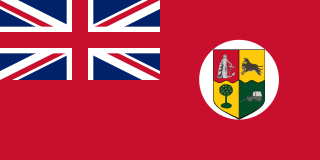 W
WThe South African Red Ensign was used as the unofficial flag of the Union of South Africa between 1910 and 1928. The flag was a red ensign defaced with the Coat of arms of South Africa on a white disc.
 W
WThe flag of Southern Rhodesia was a blue ensign, later changed to a sky-blue ensign, with the coat of arms of Southern Rhodesia on it. The flag was in use in Southern Rhodesia from 1923 to 1953 and from 1964 to 1965. It was also used by the unrecognised Rhodesia from 1965 to 1968. The flag was initially used unofficially internally before being approved for use outside of the colony by the Colonial Office in 1937. The colour was changed to sky blue in 1964 to protest the treatment of Southern Rhodesia after its inclusion in the failed Federation of Rhodesia and Nyasaland.
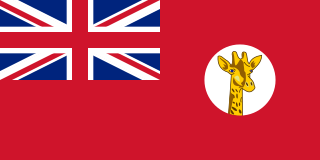 W
WThe Flag of Tanganyika between 1916 and 1961 was a British Red Ensign with a giraffe head in a white disk. It was used as the flag of Tanganyika Territory while under British Empire administration as a League of Nations mandate and later United Nations trust territory.
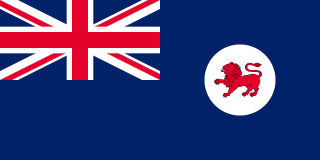 W
WThe current state flag of Tasmania was officially adopted following a proclamation by Tasmanian colonial Governor Sir Frederick Weld on 25 September 1876, and was first published in the Tasmanian Gazette the same day. The governor's proclamation here were three official flags, they being the Governor's flag, the Tasmania Government vessel flag, and a Tasmania merchant flag. Up until 1856 when Tasmania was granted responsible self-government, the Union flag and the British ensign were primarily used on state occasions.
 W
WThe Flag of Transvaal was the official flag of the Transvaal colony in South Africa from circa 1903 to 1910. It formed part of a system of colonial flags that was used throughout the British Empire. It was superseded by the flag of the Union of South Africa.
 W
WThe flag of Weihaiwei was the flag used by the British leased territory of Weihaiwei, during British rule between 1903 and 1930. The flag consisted of a British blue ensign with a pair of Mandarin ducks on it.